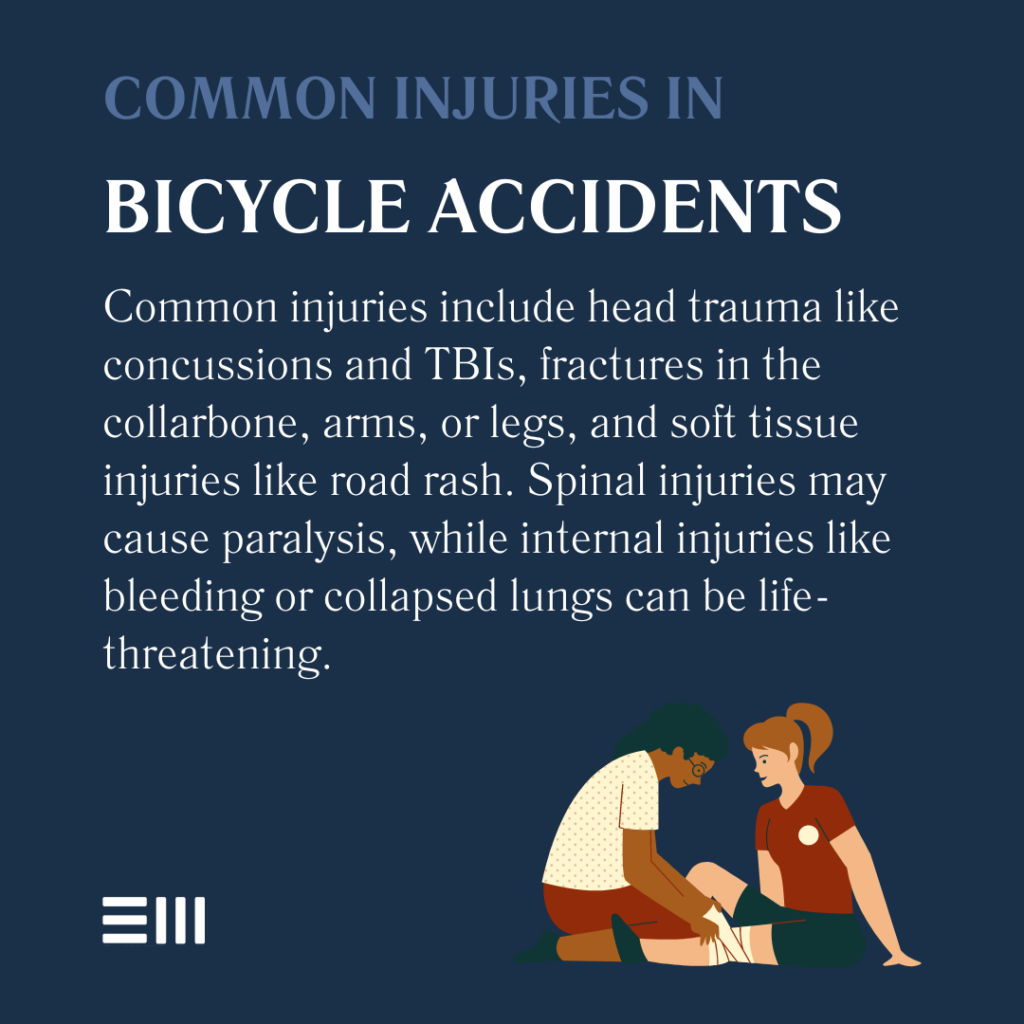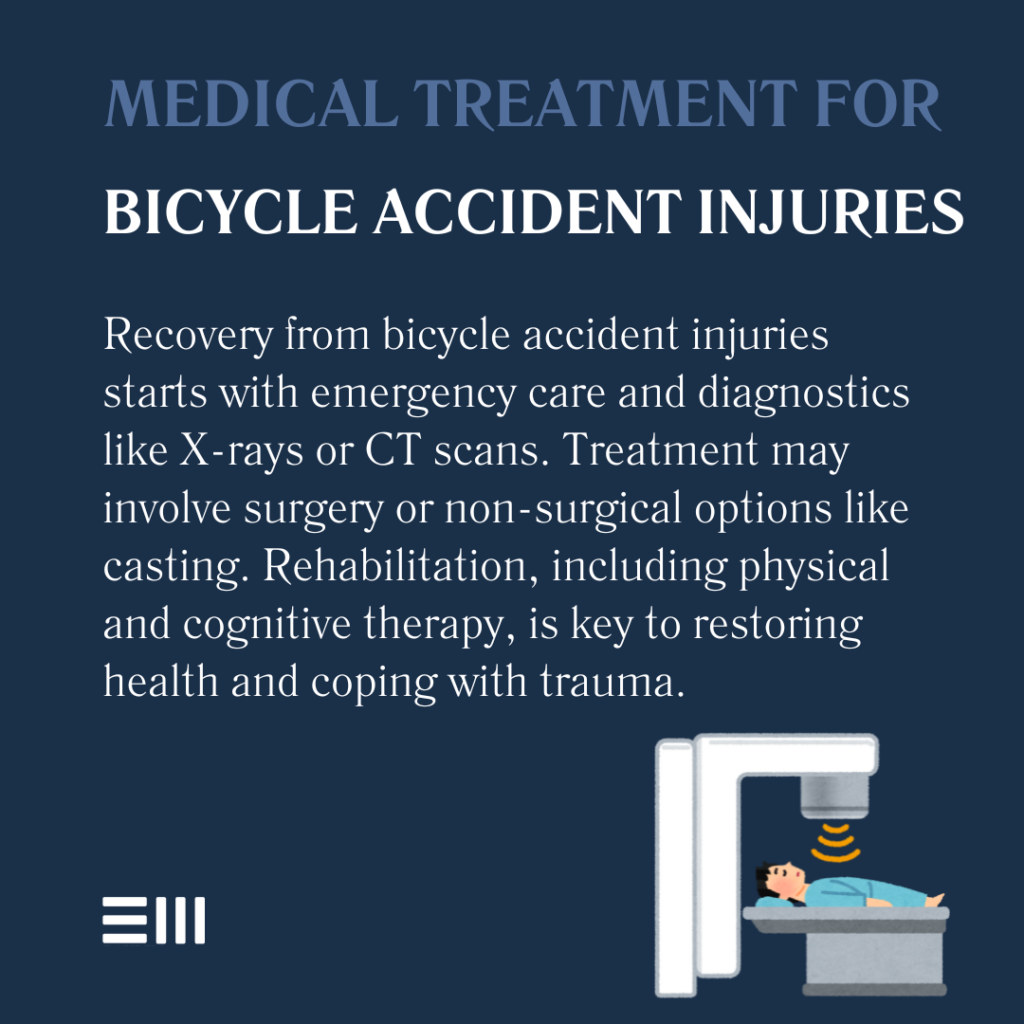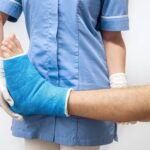
Picture this: You’re cruising down a scenic Alabama road on your bicycle, enjoying the fresh air and exercise. Suddenly, a distracted driver swerves into your lane.
In an instant, your peaceful ride turns into a life-altering accident.
In 2021, 966 cyclists lost their lives in traffic accidents across the United States, marking a 1.9% rise compared to the 948 fatalities recorded in 2020.
Here, our Alabama bicycling accident attorneys will explain the intricacies of bicycle accidents in Alabama, exploring the common injuries that can occur and the medical treatments that follow.
Introduction to Bicycle Accidents in Alabama
Bicycle accidents in Alabama can occur due to various factors, including distracted driving, poor road conditions, and lack of proper bike lanes.
Understanding the common injuries and appropriate medical treatments is crucial for cyclists and their families.
Common Injuries in Bicycle Accidents
When a bicycle collides with a vehicle or the ground, the human body absorbs tremendous forces, leading to a range of potential injuries.
Head Injuries
Head injuries are among the most serious consequences of bicycle accidents. They can range from mild concussions to severe traumatic brain injuries (TBI).
- Concussions: Often result from a blow to the head and can cause temporary loss of consciousness, confusion, and memory problems.
- Traumatic Brain Injuries: More severe impacts can lead to long-term cognitive impairments, personality changes, and physical disabilities.
Fractures and Broken Bones
Cyclists are vulnerable to fractures and broken bones due to the lack of protection during collisions or falls.
- Collarbone Fractures: Common in cyclists who fall onto their shoulders.
- Wrist and Arm Fractures: Often occur when cyclists try to break their fall with outstretched arms.
- Leg and Hip Fractures: Can result from direct impacts or being thrown from the bicycle.
Soft Tissue Injuries
Soft tissue injuries include damage to muscles, ligaments, and tendons.
- Road Rash: Abrasions caused by sliding across pavement, which can lead to infections if not properly cleaned and treated.
- Sprains and Strains: Common in ankles, knees, and wrists due to sudden twisting motions or impacts.
- Contusions: Bruising of soft tissues, which can be painful and limit mobility.
Spinal cord injuries can have devastating consequences, potentially leading to partial or complete paralysis.
- Cervical Spine Injuries: Affect the neck region and can result in quadriplegia.
- Thoracic and Lumbar Injuries: May cause paraplegia or other forms of paralysis below the injury site.
Internal Injuries
Internal injuries may not be immediately apparent but can be life-threatening if left untreated.
- Internal Bleeding: Can occur in organs like the liver or spleen due to blunt force trauma.
- Pneumothorax: A collapsed lung, which can result from rib fractures puncturing the lung tissue.
Recognizing these injuries early can significantly impact the course of treatment and recovery.

Medical Treatment for Bicycle Accident Injuries
The journey from injury to recovery often begins with critical decisions made in the immediate aftermath of an accident.
Emergency Care
Immediate medical attention is crucial following a bicycle accident to assess and treat potentially life-threatening injuries.
- On-Scene Care: First responders provide initial stabilization and triage.
- Emergency Room Treatment: Focuses on identifying and addressing critical injuries.
Diagnostic Procedures
Accurate diagnosis is essential for proper treatment planning.
- Imaging Studies: X-rays, CT scans, and MRIs help visualize bone fractures, soft tissue injuries, and internal trauma.
- Neurological Assessments: Evaluate brain function and identify potential head injuries.
Blood Tests: Check for internal bleeding and other abnormalities.

Treatment Options
Treatment varies based on the type and severity of injuries sustained.
Surgical Interventions:
- Repair of complex fractures;
- Treatment of severe head injuries; and
- Addressing internal bleeding or organ damage.
Non-Surgical Treatments:
- Casting and splinting for simple fractures;
- Medication management for pain and inflammation; and
- Wound care for road rash and lacerations.
Specialized Care:
- Neurosurgical interventions for severe head or spinal cord injuries; and
- Orthopedic treatments for complex musculoskeletal injuries.
Proper medical treatment can mean the difference between a full recovery and long-term complications.
Recovery and Rehabilitation
The recovery process after a bicycle accident can be lengthy and may require various forms of rehabilitation.
- Physical Therapy: Helps restore strength, flexibility, and mobility.
- Occupational Therapy: Assists in regaining the ability to perform daily activities.
- Cognitive Rehabilitation: Addresses issues related to memory, concentration, and other cognitive functions following head injuries.
- Psychological Support: Counseling and therapy to cope with trauma and adjustment to injuries.
Remember, recovery is a journey, not a destination. With patience, perseverance, and professional support, many cyclists find their way back to the roads and trails they once enjoyed.
Prevention and Safety Measures
While accidents can’t always be prevented, several measures can reduce the risk and severity of injuries:
- Wear Proper Safety Gear: Always use a well-fitting helmet and consider additional protective equipment like gloves and knee pads.
- Follow Traffic Laws: Obey traffic signals, use hand signals, and ride in the same direction as traffic.
- Increase Visibility: Wear bright or reflective clothing and use lights when cycling at night.
- Maintain Your Bicycle: Regular maintenance ensures your bike is in good working condition.
- Stay Alert: Be aware of your surroundings and anticipate potential hazards.
By prioritizing safety and staying informed, cyclists can minimize their risk of accidents and enjoy the many benefits of this wonderful activity with greater peace of mind.
Legal Considerations
Understanding your rights and legal options is important following a bicycle accident:
- Insurance Claims: Navigating the process of filing claims with relevant insurance companies.
- Liability Issues: Determining fault and responsibility in the accident.
- Compensation: Pursuing fair compensation for medical expenses, lost wages, and pain and suffering.
- Statute of Limitations: Being aware of time limits for filing legal claims in Alabama.
While legal proceedings may seem daunting, they can be a vital step in ensuring you receive fair compensation and support for your recovery journey.
Frequently Asked Questions About Bicycle Accidents in Alabama
Bicycle accidents raise many questions for victims and their families.
Here, we provide answers to some of the most frequently asked.
What Should I Do Immediately After a Bicycle Accident?
Ensure your safety, call 911, seek medical attention, document the scene if possible, and gather contact information from witnesses.
How Long Does Recovery Typically Take After a Bicycle Accident?
Recovery time varies greatly depending on the nature and severity of injuries. It can range from a few weeks for minor injuries to months or years for more severe cases.
Can I Still Receive Compensation If I Wasn’t Wearing a Helmet?
While not wearing a helmet doesn’t automatically disqualify you from compensation, it may affect the amount you can recover, especially for head injuries.
What If the Driver Who Hit Me Was Uninsured?
You may still have options, such as filing a claim with your own insurance company if you have uninsured motorist coverage or pursuing a personal injury lawsuit against the driver.
How Can I Prevent Infections from Road Rash?
Clean the wound thoroughly with mild soap and water, apply antibiotic ointment, cover with sterile dressings, and change the dressing regularly. Seek medical attention if signs of infection develop.
Are There Any Long-Term Effects of Concussions from Bicycle Accidents?
Some individuals may experience long-term effects such as headaches, difficulty concentrating, memory problems, or mood changes. Proper diagnosis and treatment can help manage these symptoms.
How Can I Find a Qualified Medical Specialist for My Bicycle Accident Injuries?
Consult with your primary care physician for referrals, or contact local hospitals and medical centers that specialize in trauma care or sports medicine.
Get Expert Help for Your Bicycle Accident Case
Have you or a loved one been injured in a bicycle accident in Alabama? Don’t face this challenging time alone.
The experienced team at Baxley Maniscalco is here to help you understand your rights and options.
We specialize in bicycle accident cases and can provide the guidance and support you need to navigate medical treatment, insurance claims, and potential legal action.
Contact Baxley Maniscalco today for a free consultation. Our compassionate attorneys will listen to your story, answer your questions, and help you determine the best path forward.
Can't find what you're looking for? Search our site below.










